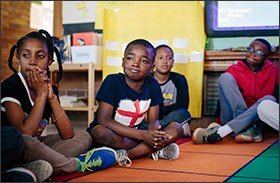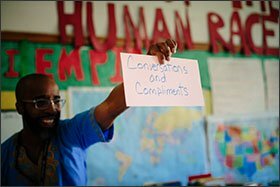Students in Perry Hollins’ 4th grade class at Oakton Elementary School, 12 miles north of Chicago, at times have trouble managing their anger. They might have arrived at school with home troubles on their mind, or they may have gotten into a dispute with a classmate on the playground.
“They’re not trying to get on adults’ nerves,” said Hollins. “They are just trying to figure out their world and their place in it, and they rely on teachers to guide them.”
Hollins has several ways of helping his students deal with these issues without veering from the curriculum. One of them is through analysis of conflicts in literature. His students read the graphic novel March, by John Lewis, the congressman and civil rights leader, who writes about the fight to end segregation through nonviolent sit-ins at lunch counters. Hollins said the book can teach students how to use their anger over injustice as an impetus for positive change.
Take the moment when the young Lewis character in March defies his mother and goes to school rather than remain at home to help out on the farm. Hollins said his students were surprised the boy had disobeyed his mother. But they also recognized the injustice of Lewis’ predicament. That sparked a conversation about getting into “good trouble.” In this scenario, Hollins suggested asking: How does the character solve the problem? Could he have done something better? What would you have done?
Like many other teachers of language arts, social studies, and math, Hollins is using social-emotional learning, or SEL—teaching students to manage emotions, make responsible decisions, build relationships—to turn everyday lessons into preparation for civic engagement. The goal is to get students to reflect on their emotions and to deal with them in productive ways. A reading or math lesson can teach students to see their personal challenges as part of a wider struggle, where people work together to bring about change, what these teachers call social justice.
Such self-reflection doesn’t have to be intimidating.
“Discussing books and analyzing characters are ways for me to bring out social-emotional learning in a safe way,” said Hollins. “Students don’t necessarily have to deal with their own emotions directly. Without the risk of feeling exposed themselves, they are learning to work out conflict by analyzing the characters’ actions.”
Students Make a Stand
The majority of students at Oakton Elementary in Evanston, Ill., are poor and black. Each year since 1999 when the first black men’s basketball coach at Northwestern University was killed in a hate crime in neighboring Skokie, the community has held a demonstration called Stand Against Hate. This year, Hollins’ students were inspired by March to create banners that read “Black Lives Matter,” “Pride is Power,” “End Racism,” and “MLK Should Be Here Today,” which they held up outside their school. Then they devised action plans to address changes they wanted to see in their neighborhoods, such as placing cameras and guards in local parks to keep children safe.

“We can have a lot of confidence in the effectiveness of these approaches [to social emotional learning],” said Linda Dusenbury of the Collaborative for Academic, Social, and Emotional Learning, or CASEL, a research and advocacy group. “The research shows that social-emotional awareness can be weaved effectively into academics.” She pointed to the results of 213 separate studies that have shown improved academic outcomes in the form of increased test scores, as well as a reduction in discipline referrals, improvement in social-emotional adjustment, and reduced anxiety.
Janna Moyer stresses that none of these social-emotional teaching techniques should be dismissed as group therapy. As the Social Emotional Learning specialist at Procter Hug High School in Reno, Nev., Moyer helps teachers of all subjects to guide students into considering multiple perspectives when analyzing an issue and to develop communication skills that will help them positively interact with others. “We’re not just talking about emotions,” she said. “We are developing skills that kids need in a career, in their adult relationships, as voters and as citizens.”
Developing Self-Efficacy
The goal of Moyer’s speech and debate class is to teach students how to make themselves heard. Her students follow legislative bills, including one that would impose time limits on the testing of rape kits, and then analyze the various arguments for and against. Students have even testified at legislative hearings in favor of bills they supported.
The majority of students at Procter Hug High are Hispanic, and the entire student body receives free lunch. They feel they get stereotyped because their neighborhood is not the best in the area, according to Moyer. So the students decided to work on improving the neighborhood’s image. Their ideas included placing recycling bins alongside trash cans at bus stops, something they’d seen in higher-income neighborhoods. They also suggested better lighting for an area where witnesses of a shooting could not make out the license plate of the getaway car and a mural to dress up a plain wall. The students wrote up their ideas and presented them to the City Council, which promised to do a walk-through of the area in need of lighting.

“Afterwards, the kids felt a sense of self-efficacy that, ‘Hey, the mayor listened to me about what I thought my neighborhood needed,’” Moyer said. “They offered solutions, and the council was open to their ideas, and they learned that self-efficacy isn’t whining. It’s about having a sense of control over what you want to see happen.”
It’s that sense of control that math teacher Kelly Boles wants to impart to her students in her statistics class at Betsy Layne High School in rural, eastern Kentucky. Boles also co-leads a Teach For America-sponsored online course on the edX platform called “Teaching Social Justice Through Secondary Mathematics.” She teaches students to respond rationally to data that provokes strong emotions, without immediately responding with arguments. She does so by having them focus on the wider implications of data. It’s making math relevant, but the ultimate goal is to get kids to start asking certain questions of the data that ultimately could lead to civic action.
The concepts taught in statistics are often abstract and difficult for students to grasp or relate to, Boles said. But when she presented data sets on gross domestic product and life expectancies for various countries, her students immediately saw the relevance and began asking interesting questions.

“Instead of talking about x and y variables, students started talking about GDP and life expectancy, and ‘Why does this country have such a high life expectancy per capita relative to other countries, and why is this one so low?’ ” Boles said. “Standard questions look at the lengths of the wings of a particular type of fly. That is hard for kids to have real interest in. But when you talk about life expectancy or labor or slave labor, even if they don’t identify with it, they latch onto it as something that is real about their world.”
Students analyzing the data noticed that as GDP increased, so did life expectancy. They wanted to know what that meant. They did research and found that richer countries have more medical resources. That finding led them to ask more questions: “How is it fair that a child my age in a poorer country might live 20 years less than I will?” These are the kinds of questions that may well lead to civic action, and not because of the teacher’s prompting but through students’ own analysis, Boles said.
Students asking questions about fairness and equity—that’s the sign of a healthy mind, according to Hollins. He stresses the imperative of teachers helping students get there, to become fully actualized adults.
“If we really want to produce mentally stable, healthy citizens, we have to make room for social and emotional learning,” Hollins argued. “Students bring all of themselves into the learning experience, and teachers can’t just say, ‘Keep those emotions on hold.’ That would invalidate [students’] experience.”



